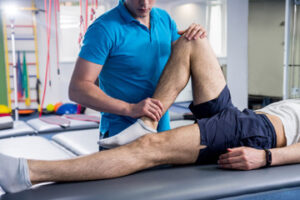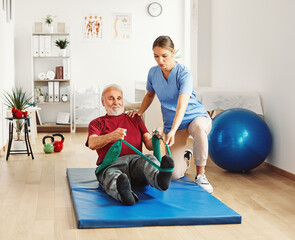Sports Massage Tulsa are a form of bodywork focused on preparing the muscles for exercise and increasing their flexibility. This decreases the likelihood of injury and increases both the effectiveness and duration of exercise.

Amateur athletes often put their bodies through the same high rates of physical strain as professional athletes, and they benefit greatly from specialized sports massage. However, anyone can benefit from this form of massage.
A pre-event massage is a light, stimulating session usually administered 24 hours or less before the event to prepare the body for maximum performance. This treatment helps eliminate toxins, alleviates pain and increases flexibility.
This type of massage should compliment and not replace your normal warm up routine. The goal of a pre-event massage is to increase blood flow to the muscles that are being exercised during your event, and to help prevent muscle injuries by reducing tightness and tension. Typical techniques used in this type of massage include effleurage (stroking towards the heart), tapotement (rhythmic percussion), friction, petrissage (kneading), and deep compressions to the belly of the muscle. The aim is to prepare the muscles for the event by warming up and elongating the muscles, allowing the muscle fibres to contract more efficiently. This is especially important for explosive or powerful events such as sprinting, power lifting or boxing.
The therapist will also identify any areas of tightness and stretch these out to improve the muscle’s length-tension relationship, which reduces the risk of injury. A pre-event massage can also have a psychological effect, allowing the athlete to feel confident and able to perform at their peak by reducing anxiety.
During the course of any sporting activity it is common for toxins to build up in the muscles, these toxins are known as lactic and pyruvic acids. When these acids build up in the muscles they can cause muscle soreness, stiffness and delay recovery times. The main purpose of a post-event massage is to speed up the process of recovery from exercise and alleviate any sore or stiff muscles. It also helps prevent DOMS (Delayed onset of Muscle Soreness).
The post-event sports massage is performed as soon as possible after the sporting activity and is best suited for within 48 hours of the activity. During this type of massage the therapist will focus on the key areas of the body that have been exercised, to help speed up the process of recovery and remove any toxins. This is an important massage to have if you are an elite sportsperson, as it will help you achieve your best result and will assist in preventing future injury.
Post-Event Massage
The Post-Event Massage is performed after a competition or intense training session to help aid the recovery process. It can be performed from 30 minutes up to 48 hours after exercise and helps the body remove metabolic waste (such as lactic acid) that has built up during exercise. This waste can contribute to delayed onset muscle soreness and stiffness.
This massage works to improve the body’s ability to reduce inflammation and increase vascular flow to speed up recovery time. It also helps to alleviate any tight muscles caused by the exercise or the build up of toxins. This massage is a great way to ease any discomfort and allow the athlete to perform at their best in their next training session or event.
Pre-Event Massage
A pre-event massage is a short treatment usually no more than 15 to 30 minutes performed the day before a sporting event. It is designed to stimulate the muscles at a higher pace than normal therapeutic massage and is often faster and lighter in nature. This can help to psych up an athlete and get them in the right mind set for their competition. The techniques used are similar to that of a deep tissue massage however the pressure is generally lighter and more fluid in nature.
During the pre-event massage the therapist is looking for any tense or shortened muscles that are not functioning correctly and may be contributing to poor performance. They are also checking for any areas of the muscle that may be tight and limiting movement. A pre-event massage will also include any stretching or myofascial release to help loosen the larger muscles and reduce tightness.
The physiological effect from a sports massage is warmth which increases the metabolic rate and improves the condition of the muscle tissues, fascia tissue, ligaments and tendons. Warm muscles contract more efficiently and are less prone to strains or sprains.
A good sports massage therapist will understand that the client is not only looking to relax and recover but they are also looking to meet their specific training goals. They will therefore be able to adjust the treatment accordingly. This is a great skill to have and a vital component of any sports massage therapists tool kit.
Post-Training Massage
If you are a regular exerciser, then chances are your muscles will need some attention and care after those high-intensity workouts. Regular massage increases the flow of fresh blood to the muscle tissues, which helps in repairing and rehydrating them. It also decreases stiffness and helps your muscles contract more efficiently, thus reducing the chance of injury.
It helps you to keep a balanced schedule of training and rest, which is a key factor in preventing injuries. If you do sustain an injury, this type of sports massage reduces scar tissue formation and alleviates pain and discomfort. It also helps in rebalancing the body, so that it doesn’t strain the injured area again in future.
In the event that you are competing in a race or are doing a long-distance walk, then this type of sports massage is used to help you achieve peak performance. It is usually done within 24 hours of the event or competition and focuses on those areas that are likely to be exerted. The session is designed to flush the tissues of lactic acid and other waste products, alleviates cramping, and relaxes the muscles.
Another important role of this type of massage is that it aids in the recovery process after an event or competition. Muscle soreness and stiffness are normal after a big effort, but if you wait too long to get a massage, then the muscles may become overstretched. Massage is effective in reducing the occurrence of DOMS (delayed onset muscle soreness).
A good quality post-event massage also increases lymphatic drainage. During exercise, our bodies accumulate toxins and metabolic waste in the form of lactic and pyruvic acids. These toxins are then removed from the muscles via lymph fluid. When this fluid is not cleared quickly, it can lead to swelling and discomfort. Massages that are performed regularly, increase lymphatic drainage and decrease the build up of toxins and waste, which leads to quicker and more efficient recoveries.
As a general rule, athletes should consider getting a post-training massage once a week. This is particularly important for beginners, who are more susceptible to overtraining and injury than those with a bit of experience under their belt.
Rehabilitative Massage
A rehabilitative sports massage is designed to aid the body to repair itself and manage any injuries that have occurred. Whether you have an injury from a workout or a specific incident, a rehabilitative sports massage helps your recovery by alleviating pain, improving flexibility, and promoting circulation. These are essential in allowing the healing process to work effectively and speedily. It also helps you to maintain optimal physical condition so you can perform at your best in training or competition.
Unlike a regular massage, sports massage incorporates techniques such as friction and deep tissue massage. Using their thumbs and fingers, the therapists manipulate the soft tissues to release any adhesions that have formed in the muscles. The friction technique increases blood flow in the muscles, which promotes the removal of waste materials from the muscles and prevents a build-up of lactic acid. This lactic acid can lead to muscle soreness and stiffness.
In addition to improving the condition of the muscles, ligaments and tendons, sports massage also reduces the risk of strains and sprains by encouraging the proper contraction of the muscles. A rehabilitative sports massage helps you to perform better in your sport or in your daily activities.
A regular sports massage can also help you avoid overtraining. It can reduce the accumulation of toxins and the build-up of muscle waste, such as lactic and pyruvic acids. Moreover, it helps reduce delayed-onset muscle soreness (DOMS) that may arise after an exercise or from overuse.
Another benefit of a sports massage is that it can help improve the elasticity of your muscles. This is because the rehabilitative massage techniques of friction and effleurage can increase the stretchability of your muscles by breaking down any adhesions.
Adhesions are inflexible bands of tissue that form within the soft tissues and between damaged muscle fibres. They are a result of past injury and inflammation and can cause discomfort and restrict movement. Sports massage uses a variety of massage techniques, such as friction, kneading and vibration, to break down scar tissue and help the healing process. Scar tissue can impede the suppleness of your muscles and joints, so it is important to have them broken down if you want to be injury-free.

